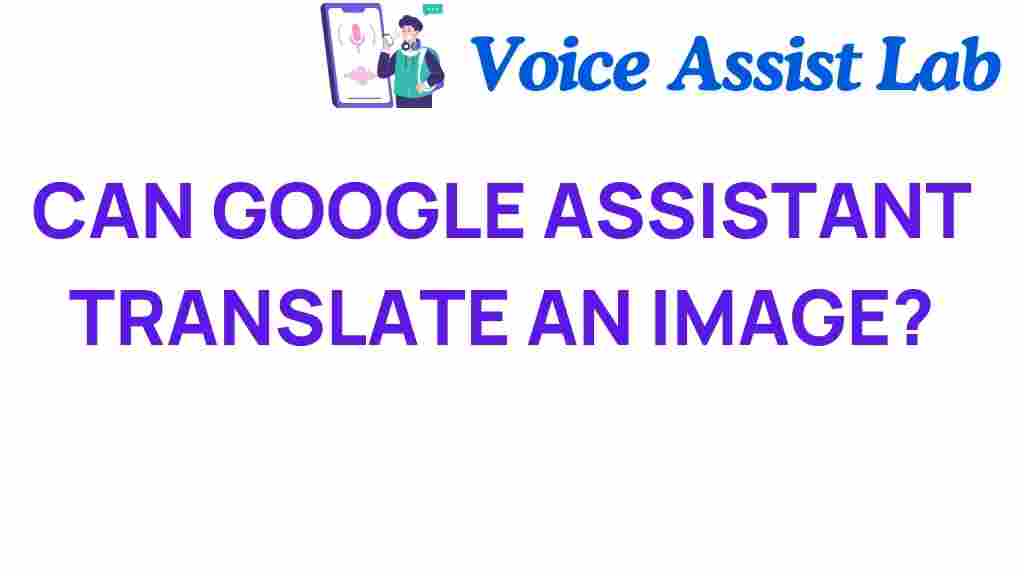Can Google Assistant Decode Your World Through Images?
In an increasingly interconnected world, the ability to communicate across language barriers has never been more crucial. With advancements in technology and the rise of artificial intelligence (AI), mobile apps are evolving to offer solutions that were once the stuff of science fiction. One of the most exciting innovations in this space is the ability of Google Assistant to translate images, effectively decoding the world around us. This article explores how Google Assistant utilizes image translation technology to break down language barriers and enhance accessibility.
Understanding Google Assistant’s Image Translation Feature
Google Assistant is a powerful digital assistant designed to make information and services accessible at your fingertips. One of its standout features is the ability to translate text within images. This functionality is particularly valuable for travelers, students, and anyone navigating multilingual environments.
How Does Image Translation Work?
Image translation harnesses the power of AI and machine learning to analyze images, identify text, and translate it into the user’s preferred language. The steps involved in this process include:
- Image Capture: Users can take a picture of text or use an existing image from their gallery.
- Text Recognition: The AI algorithms recognize and extract text from the image.
- Translation: The extracted text is then translated into the desired language.
- Display: The translated text is displayed on the screen, allowing users to read and understand the information.
Step-by-Step Process to Use Google Assistant for Image Translation
Using Google Assistant for image translation is simple and efficient. Follow these steps to decode your world through images:
- Open Google Assistant: On your mobile device, activate Google Assistant by saying “Hey Google” or by tapping the Assistant icon.
- Request Image Translation: Say “Translate this image” or type a similar command in the chat interface.
- Capture or Upload an Image: You will be prompted to take a photo or select an image from your gallery. Choose the appropriate option.
- Select the Target Language: Choose the language you want the text to be translated into.
- View Translated Text: Once the translation is complete, Google Assistant will display the translated text on your screen.
Benefits of Using Google Assistant for Image Translation
The integration of image translation into Google Assistant presents several advantages:
- Bridging Language Barriers: It enables seamless communication in foreign languages, making travel and learning more accessible.
- Enhancing Accessibility: Those with limited language skills can easily understand signs, menus, and documents in different languages.
- Convenience: The feature is easily accessible on mobile devices, allowing users to translate text on-the-go.
- Real-Time Translation: Users can receive instant translations, which is crucial in time-sensitive situations.
Troubleshooting Common Issues with Google Assistant’s Image Translation
While using Google Assistant for image translation is generally smooth, users may occasionally encounter issues. Here are some common problems and troubleshooting tips:
Problem 1: Poor Image Quality
Solution: Ensure that the image is clear and well-lit. Avoid taking pictures from awkward angles or in low-light conditions, as this can hinder text recognition.
Problem 2: Incorrect Translations
Solution: If the translation seems inaccurate, try capturing the text again. Ensure that the text is legible and not obstructed by other objects.
Problem 3: App Crashes or Freezes
Solution: Regularly update your Google Assistant app to the latest version. If problems persist, consider restarting your device or reinstalling the app.
Problem 4: Language Not Supported
Solution: Check Google Assistant’s supported languages in the settings. If the language you require is not available, try using a third-party translation app such as Google Translate.
The Future of Image Translation Technology
The continued development of image translation technology represents a significant leap toward breaking down language barriers globally. As AI capabilities expand, we can expect even more refined and contextually aware translations. Future innovations may include:
- Augmented Reality (AR) Integration: Imagine wearing AR glasses that instantly translate text in real-time as you view it. This could revolutionize travel and education.
- Contextual Understanding: Enhanced AI could recognize the context of phrases, leading to more accurate translations that account for idiomatic expressions and cultural nuances.
- Voice Integration: Users may be able to speak commands to translate images verbally, making the process even more intuitive.
Conclusion
Google Assistant has emerged as a key player in the quest to decode our world through images. By leveraging image translation technology, it offers a powerful tool for overcoming language barriers, enhancing accessibility, and fostering communication in an increasingly multilingual society.
As we continue to witness remarkable innovations in technology, the future holds exciting possibilities for improving and expanding these capabilities. With the right tools and knowledge, navigating the complexities of language differences can become a seamless experience for everyone.
To learn more about how Google Assistant can enhance your daily life, consider exploring additional features it offers. For a deeper dive into the world of language translation, you can visit this informative resource.
This article is in the category Innovations and created by VoiceAssistLab Team
